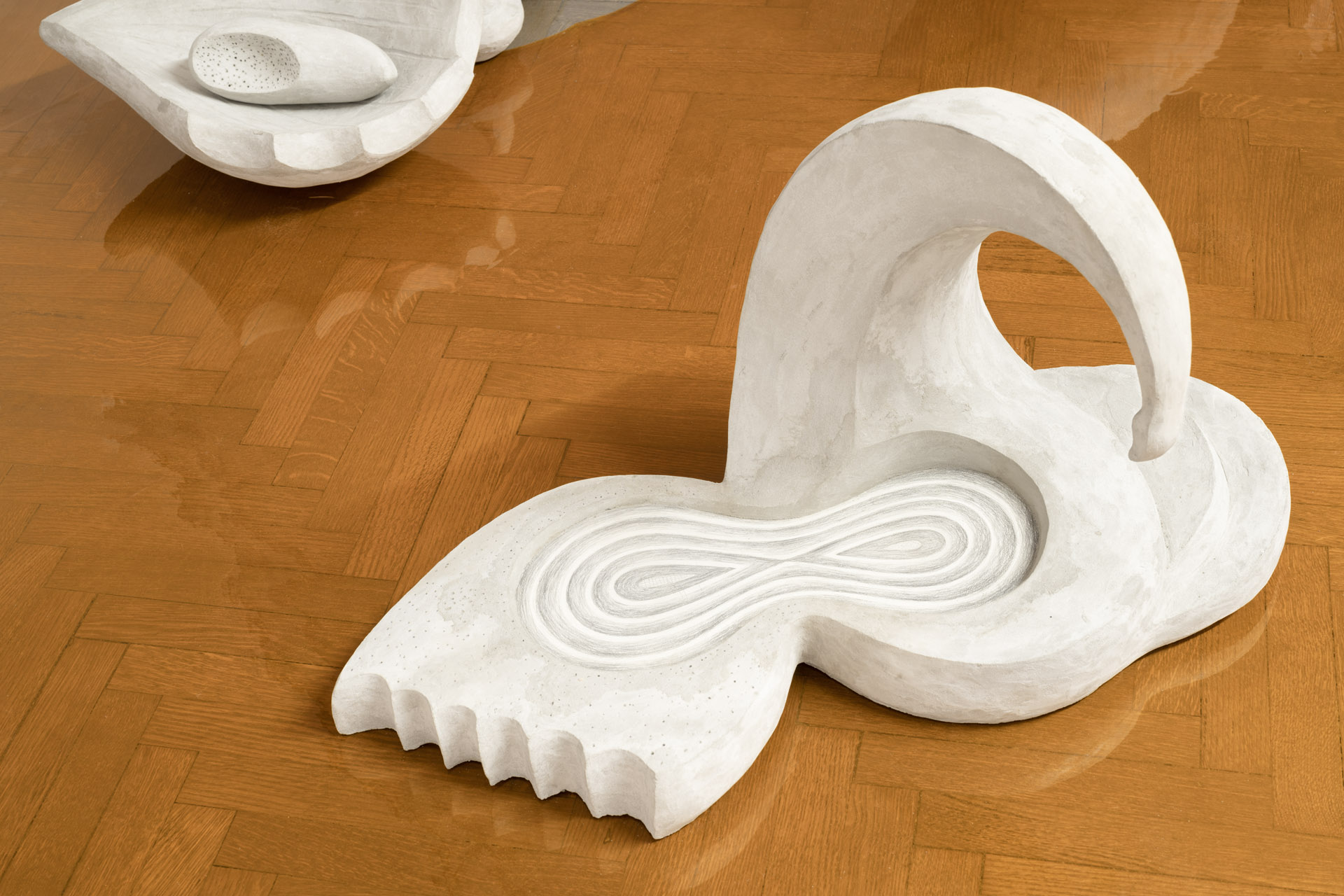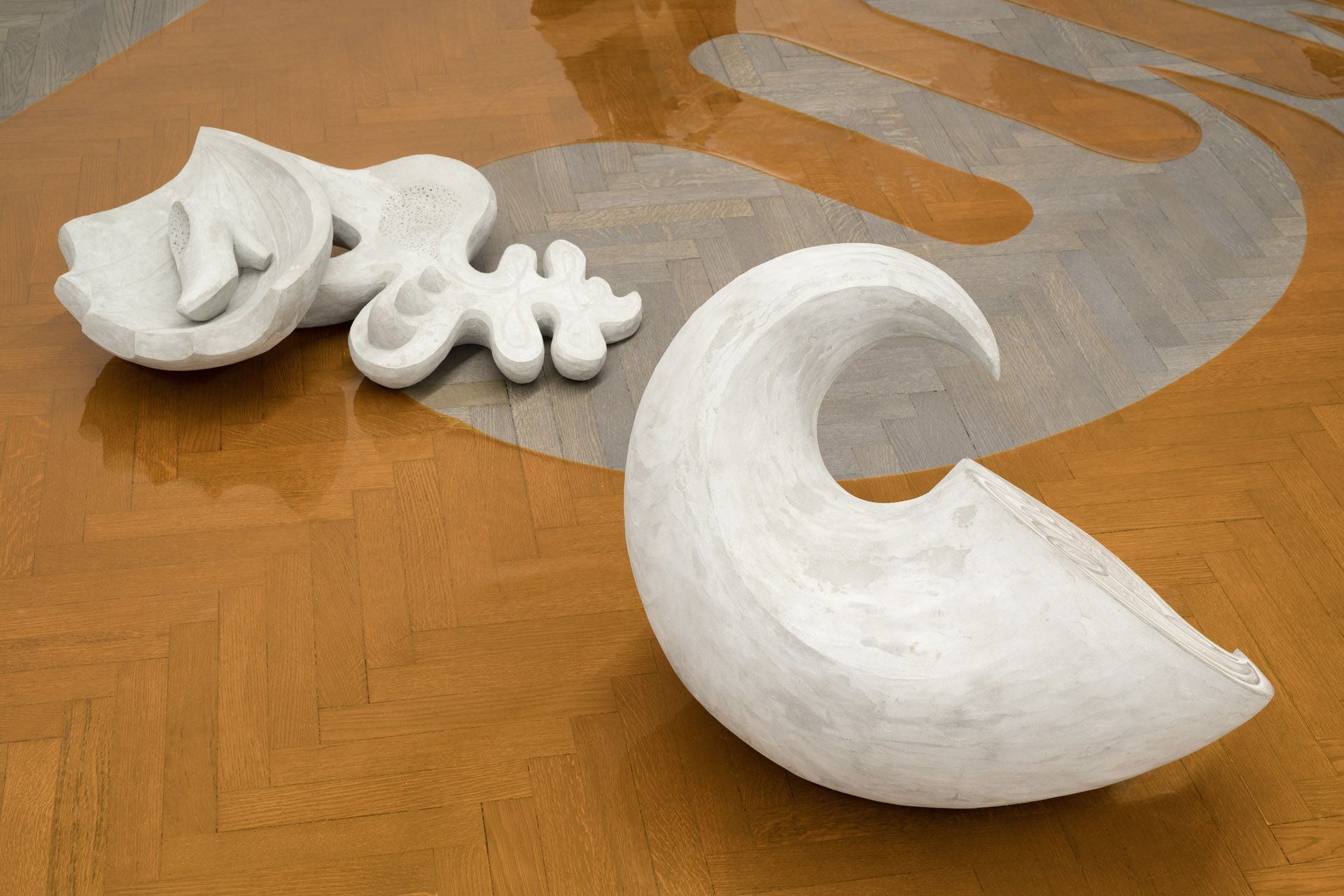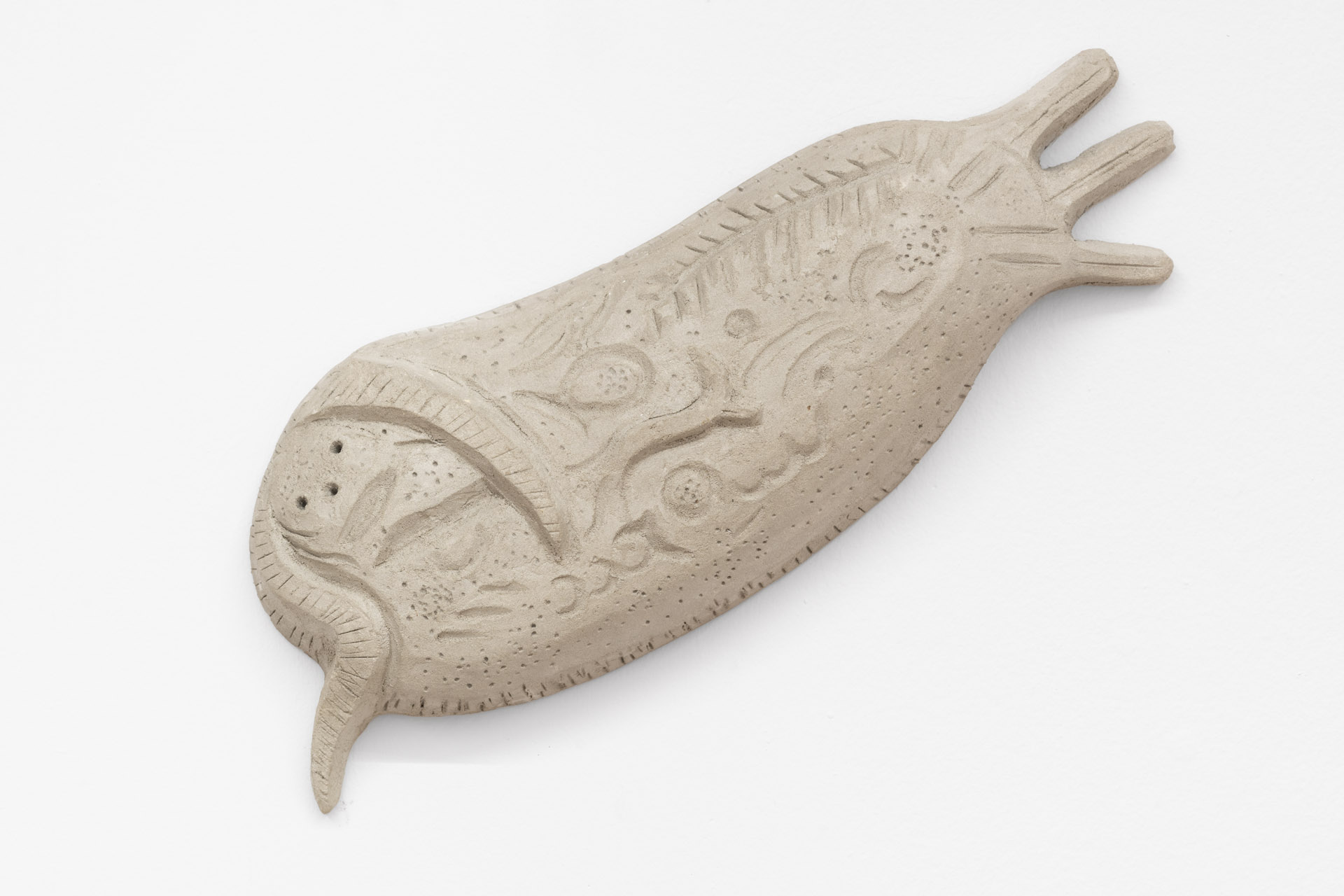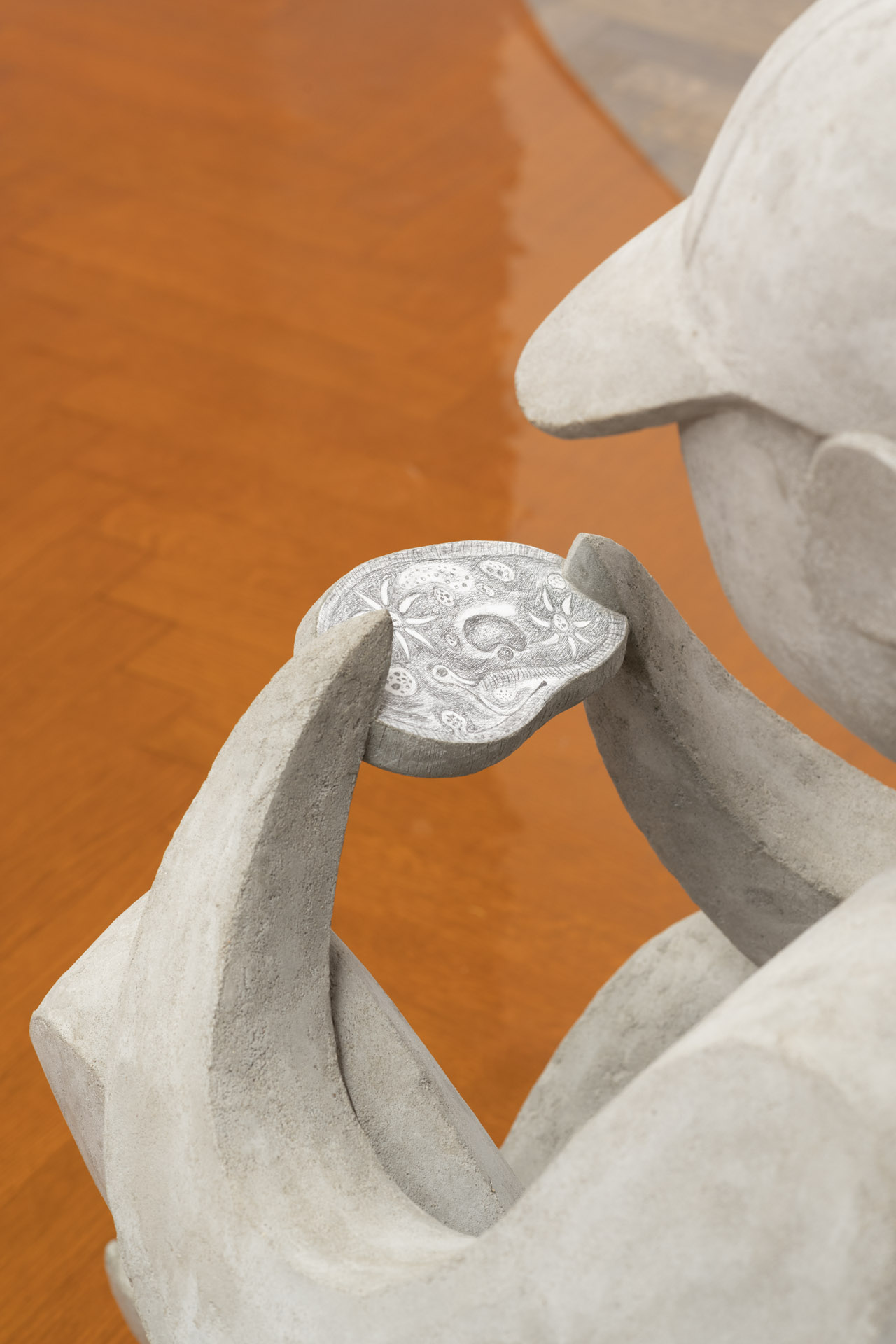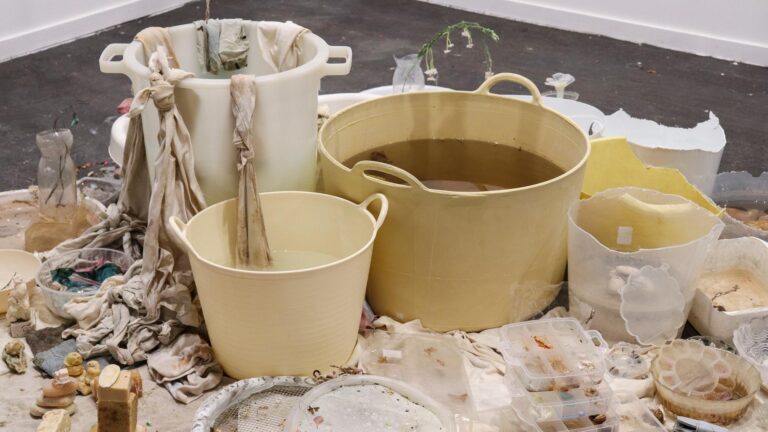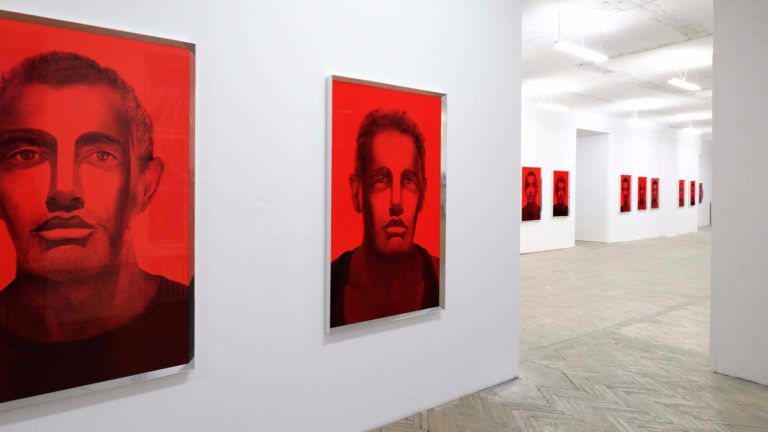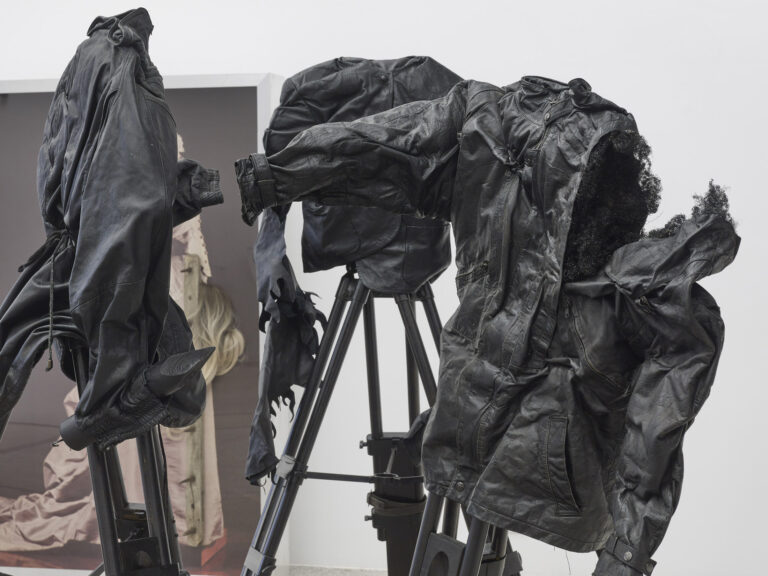Artist: Anna Hulačová
Exhibition title: Alienbees, save us, please!
Curated by: Katarzyna Różniak
Venue: Arsenal Gallery, Białystok, Poland
Date: November 19, 2021 – January 10, 2022
Photography: all images copyright and courtesy of the artist and Arsenal Gallery, Białystok
Work of the Czech sculptor, Anna Hulačová, is characterised by a multiplicity of cultural and historical-artistic references. Pieces presented at her exhibition, Alienbees, save us, please!, contain allusions to Greek mythology, science-fiction iconography, Modernism in architecture, Surrealism and Soc-realism, and are based on numerous dualisms: utopia vs. dystopia, the past vs. the future, human vs. machine, individuality vs. collectivity, organicity vs. technology, fluidity vs. solidity, and finally, life vs. death.
A starting point to her installation exhibited at the Arsenal Gallery in Białystok are sculptures selected from the series, Cooperation, dedicated to industrialization of agriculture. In Czechoslovakia, the process was related to collectivisation: the land, previously distributed among individual farmers, was forcibly combined into large, modern farms with a destructive impact on the environment. Industrialisation of agriculture formed a part of a wider process of industrialisation, reflected in art by means of utopian visions of a future symbiosis between the human and the machine. The 1920s was a time when Otto Gutfreund, a significant artist for Hulačova, created groups of sculptures representing people operating machines. Labour, collectivisation, a tension between the individual and society, individuality and the collective were also typical motifs in Socialist Realism. Hulačová continues, expands and modernises those historic art themes, approaching them with humour, as she fills the exhibition space with hybrid, technological-anthropomorphic and technological-biomorphic beings. Besides figures operating agricultural machinery, she also presents contemporary guises of the relationship between the human and technology (for instance, a figure with a phone).
In the wake of the Velvet Revolution (1989), the previously collectivised farms were completely privatised and became links in the global chain of food production, exploiting the natural environment in the chase of profits. The use of pesticides was becoming increasingly prevalent. Intensive agriculture with use of chemicals, industrialization causing environmental pollution, accelerating climate change are listed as main causes of a radical decrease in insect populations. Species most threatened with extinction are: bees, moths, butterflies, beetles, and dragonflies. Raised and based in the countryside, the sculptor observes those phenomena in her immediate surroundings, and represents their effects in the shape of an inhospitable landscape straight from cinematic or literary dystopia. As from a toxic swamp, mutated life-forms thus emerge from an orange, transparent foil, the colour of which suggests a warning against dangerous chemicals. A past utopia becomes a dystopia of the future: industrialization of agriculture turned out to be disastrous for insects and other organisms living in the natural environment, including the human kind.
Insects, bees in particular, are a consistently recurring motif in the sculptor’s work. At the Arsenal Gallery, they mutate into hybrid beings, combining with home electronics and post-human elements. One of the sculptures represents copulating moths; from their flat, intertwined backs, human eyes are looking at us through glasses. The surrealist, post-apocalyptic landscape is observed, in turn, by three anthropomorphic bees seated on a table. An inspiration for the titutal Alienbees came from a cover of a Czech science fiction magazine. Hulačová remembered it from her childhood in the 1990s: a period when people in her surroundings were fascinated with crop circles and sci-fi short stories. Belief in paranormal phenomena is on the rise in times of social unrest. This is one of the reasons why Hulačová’s memory of regime transformation years seems so pertinent to the current reality, suffering a profound and multi-layered crisis.
Bees fascinate the artist not only due to the phenomenon of mass extinction, but also because of a role they are ascribed by numerous cultures of creatures connecting the world of the living with the nether world, moving between life and death. In Greek mythology, Aristaeus’s bees emerged from corpses of animals he had sacrificed. The ‘re-incarnatory’ potential is also alive in water, omnipresent in the Czech sculptor’s work, as it flows between beings, disrespecting the boundary between life and death. Shapes of water microorganisms form a basis for a large portion of her sculptures and drawings in pencil used as their embellishments. Discussing Hulačová’s output, scholars observe a relationship between her ‘fluid’ pieces and hydro-feminist theory, in which human individuality becomes diffused in a post-humanist world thanks to recognition of a building material common to all earthly beings. “Water as body; water as communicator between bodies; water as facilitating bodies into being. Entity, medium, transformative and gestational milieu. All of this enfolding in, seeping from, sustaining and saturating, our bodies of water” Astrida Neimanis expounds. Hulačová is fascinated by the ‘common DNA’ or ‘soul’, but a choice of material used to create her ‘beings’ is subversive. In the context of fluidity of her representations, concrete – material typifying the industrial age – strikes us with its solidity, which may symbolise a deadly dryness of landscape caused by excessive exploitation of natural resources. Gazing into an upscaled aquatic organism held in his hand, A Boy with a Microbe reminds us that our future will be decided upon by accessibility of water.
The exhibition title is a cry for help. But we can only ask Hulačová’s bees – represented as insect-like extraterrestrials, with their origins in the world of science fiction – for help if we cease to perceive them as ‘aliens’. Neimanis asks: “What sort of ethics and politics could I cultivate if I were to acknowledge that the unknowability of the other nonetheless courses through me—just as I do through her?”
Anna Hulačová, Alienbees, 2021, Concrete, pencil on silk, Courtesy of the artist and hunt kastner, Prague, Photo Tytus Szabelski
Anna Hulačová, Alienbees, save us, please! Exhibition view at Arsenal Gallery in Bialystok, Courtesy of the artist and hunt kastner, Prague, Photo Tytus Szabelski
Anna Hulačová, Cooperation 6 (Man with a Hot Blower), 2021, Concrete, polymer clay, steel, pencil, paint on metal sheet, Courtesy of the artist and hunt kastner, Prague, Photo Tytus Szabelski
Anna Hulačová, Alienbees, save us, please! Exhibition view at Arsenal Gallery in Bialystok, Courtesy of the artist and hunt kastner, Prague, Photo Tytus Szabelski
Anna Hulačová, Agro-boot, 2018, Concrete, pencil, paint on metal sheet, Courtesy of the artist and hunt kastner, Prague, Photo Tytus Szabelski
Anna Hulačová, Cooperation 2 (Man with an Engine), 2020, Concrete, pencil, paint on metal sheet, Courtesy of the artist and hunt kastner, Prague, Photo Tytus Szabelski
Anna Hulačová, Cooperation 2 (Man with an Engine), 2020, detail, Concrete, pencil, paint on metal sheet, Courtesy of the artist and hunt kastner, Prague, Photo Tytus Szabelski
Anna Hulačová, Alienbees, save us, please! Exhibition view at Arsenal Gallery in Bialystok, Courtesy of the artist and hunt kastner, Prague, Photo Tytus Szabelski
Anna Hulačová, Cooperation 4 (Emergency Call), 2021, Concrete, pencil, paint on metal sheet, Courtesy of the artist and hunt kastner, Prague, Photo Tytus Szabelski
Anna Hulačová, TV show, 2018, detail, Concrete, Courtesy of the artist and hunt kastner, Prague, Photo Tytus Szabelski
Anna Hulačová, We Are in This Together, 2018, detail, Concrete, pencil, paint on metal sheet, Courtesy of the artist and hunt kastner, Prague, Photo Tytus Szabelski
Anna Hulačová, Untitled, 2018, Concrete, pencil, paint on metal sheet, Courtesy of the artist and hunt kastner, Prague, Photo Tytus Szabelski
Anna Hulačová, Alienbees, save us, please! Exhibition view at Arsenal Gallery in Bialystok, Courtesy of the artist and hunt kastner, Prague, Photo Tytus Szabelski
Anna Hulačová, Alienbees, save us, please! Exhibition view at Arsenal Gallery in Bialystok, Courtesy of the artist and hunt kastner, Prague, Photo Tytus Szabelski
Anna Hulačová, Alienbees, save us, please! Exhibition view at Arsenal Gallery in Bialystok, Courtesy of the artist and hunt kastner, Prague, Photo Tytus Szabelski
Anna Hulačová, Microbes, 2017–18, Concrete, Courtesy of the artist and hunt kastner, Prague, Photo Tytus Szabelski
Anna Hulačová, Microbes, 2017–18, detail, Concrete, Courtesy of the artist and hunt kastner, Prague, Photo Tytus Szabelski
Anna Hulačová, Cooperation 5 (Boy with a Microbe), 2020, Concrete, pencil, paint on metal sheet, Courtesy of the artist and hunt kastner, Prague, Photo Tytus Szabelski
Anna Hulačová, Cooperation 5 (Boy with a Microbe), 2020, Concrete, pencil, paint on metal sheet, Courtesy of the artist and hunt kastner, Prague, Photo Tytus Szabelski












